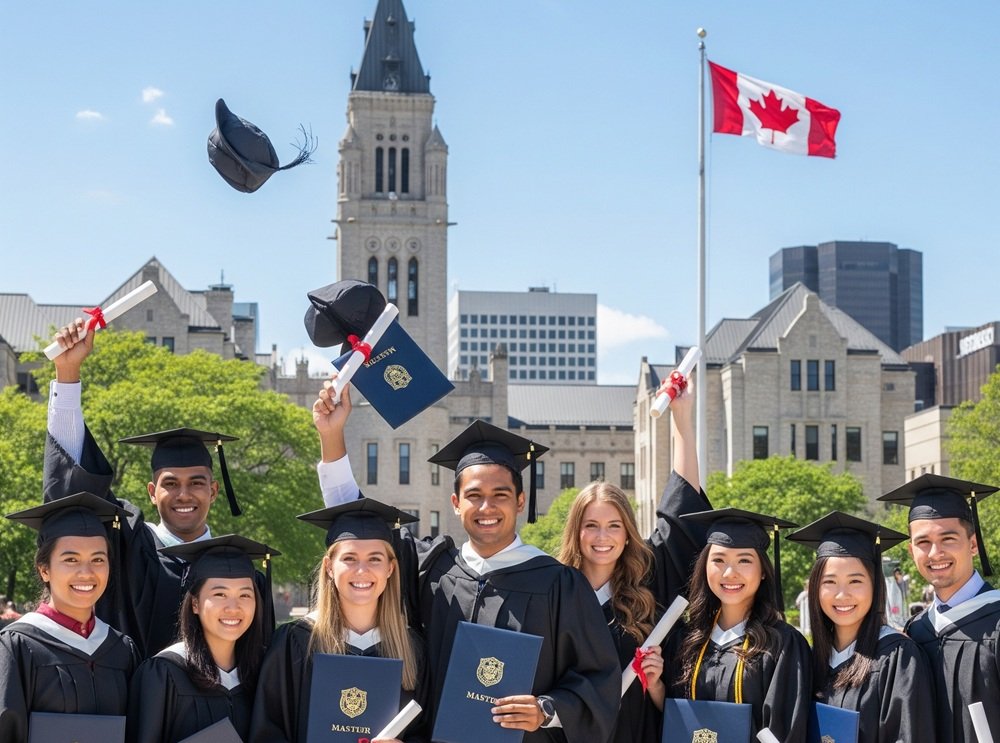Are you thinking about following a master’s degree in Canada? If so, that’s awesome.
Honestly, it’s one of the best decisions you can make.
But let’s be real, applying for a master’s degree can feel like a bit of work.
This is because there are forms to fill out, documents to prepare, and deadlines to remember.
Anyway, as of now, there’s nothing to stress about. Whereas we are here to break it all down for you in an easy-to-follow guide.
Therefore, by the end of this post, you’ll know exactly what to do at the right time.
Table of Contents
ToggleWhy Choose Canada for Your Master’s Degree?
Alright, so why Canada?
Well, for starters, Canada is home to some of the best universities in the world.
To be honest, we’re talking about top-level institutions with effective opportunities and programs that are recognized globally.
Plus, Canadian universities are known for their inclusivity and welcoming environment, where International students feel right at home.
Another big reason is the quality of life that you can get.
Whereas Canada consistently ranks high on safety, healthcare, and overall happiness.
Oh, and did we mention the post-study work opportunities? Well, after completing your degree, you can be eligible for a Post-Graduation Work Permit (PGWP), which lets you gain valuable work experience in Canada.
So, it’s kind of a win-win situation, don’t you think?
Eligibility Criteria for Master’s Programs in Canada
Before we get into the process of applying, let’s talk about whether you’re eligible or not
Remember that each university and program might have slightly different requirements, but here’s a general idea:
- Bachelor’s Degree: You’ll need a completed undergraduate degree in a related field. Some programs might also ask for a minimum GPA.
- Work Experience: Certain programs, especially in business or engineering, might require relevant work experience.
- Language Proficiency: Since English or French is the primary language of instruction, you’ll need to prove your proficiency through tests like IELTS or TOEFL.
How to Apply for a Master’s Degree in Canada – Step-by-Step Guide
Step 1: Choose the Right University and Program
Choosing where and what to study is the foundation of your entire application process.
Also, this is where you set the tone for your academic and professional future, so take your time here.
Note: Don’t just pick a university because it’s famous or because your friend recommended it—think about what you need.
For starters, consider the location.
Do you want to live in a busy city like Toronto or Vancouver, or would you prefer a quieter, smaller town?
With that being said, keep in mind that bigger cities might have more job opportunities but also come with higher living costs.
Next, think about tuition fees.
Canadian university fees may depend on the program you choose and the major that you are interested in.
Speaking of which, some programs, like engineering or business, tend to be pricier than other sectors.
Therefore, make sure you’re comfortable with the financial commitment before applying.
Step 2: Check Admission Requirements
Once you’ve narrowed down your list of universities and programs, it’s time to dig into the details.
Remember that each university has its own set of admission requirements, and these can change widely, even between similar programs at different universities.
So, head over to the official university website and look for the “Admissions” or “Graduate Studies” section.
Here’s what you’re likely to find:
- Academic Qualifications: Most programs require a completed bachelor’s degree in a related field. Some might also ask for a minimum GPA (often between 3.0 and 4.0, but this can change).
- Work Experience: Certain programs, especially in fields like business (MBA), engineering, or public policy, may require you to have relevant work experience. This could range from one to several years, depending on the program.
- Language Proficiency: If English or French isn’t your first language, you’ll need to prove your proficiency through tests like IELTS, TOEFL, or Duolingo. Some universities might accept alternative proof, like completing previous education in English, but it’s always best to confirm.
- Entrance Exams: Programs like business or law might require additional standardized tests like the GMAT or GRE. Therefore, check if your program requires one and plan accordingly.
Step 3: Prepare Required Documents
This is where things can be tricky.
Preparing or collecting your documents can feel overwhelming, but breaking it down into smaller tasks makes it manageable.
So, here’s what you’ll likely need:
- Transcripts: These are official records of your academic performance. Request them from your undergraduate institution well in advance, as they can take time to process.
- Letters of Recommendation: These are crucial because they provide insight into your abilities and character. Therefore, choose recommenders who know you well—professors, supervisors, or mentors—and give them plenty of time to write.
- Statement of Purpose (SOP): This is your chance to tell your story. Why do you want to follow this program? How does it align with your career goals? What makes you a great fit? And when you are writing, be specific and genuine.
- Resume/CV: Highlight your academic achievements, work experience, volunteer work, and any other relevant accomplishments. Make sure to specify it to the program you’re applying for.
- Proof of Language Proficiency: If required, submit your IELTS, TOEFL, or other test scores.
- Portfolio (if applicable): For creative programs like design, architecture, or fine arts, you might need to submit a portfolio by showcasing your work.
Step 4: Take Language Proficiency Tests (IELTS/TOEFL)
If English isn’t your first language, proving your proficiency is a must.
In a way, think of it as showing the admissions committee that you’ll be able to keep up with lectures, assignments, and discussions.
Therefore, to prove that, the two most common tests that are available are IELTS and TOEFL, but some universities now accept alternatives like Duolingo or PTE as well.
Anyway, here’s what you need to know:
- IELTS: In other words, the International English Language Testing System is widely accepted. Whereas most universities look for a minimum overall band score of 6.5, whereas with no band below 6.0.
- TOEFL: In other words, the Test of English as a Foreign Language is another popular option. Universities typically require a minimum score of 90–100 on the internet-based test (iBT).
- Duolingo: This online test is gaining popularity, especially since the pandemic. It’s quicker and cheaper than IELTS or TOEFL, but not all universities accept it yet.
Step 5: Apply Online and Pay the Fee
Applying online is the most common thing these days, and most Canadian universities have user-friendly portals.
So, once you’ve created an account, you will get instructions on the application process step by step.
With that, according to their instructions, upload your documents, fill out your personal information, and make sure everything is accurate before hitting “submit.”
Note: Don’t forget to pay the application fee! For instance, fees can range from CAD 100 to CAD 250 per application, depending on the university. While it might seem like a lot, think of it as an investment in your future.
Pro tip: Save copies of everything you submit. This is because you never know when you might need to refer back to your application or resend a document.
Step 6: Wait for Admission Decision
Now comes the hardest part—waiting.
After you hit “submit,” your application goes into the review queue.
Then, admissions committees will evaluate your academic background, test scores, SOP, and other materials.
Whereas this process can take anywhere from a few weeks to even a couple of months, depending on the university and program.
So, while you wait, start researching housing options, scholarships, and other needed resources for you.
And hey, if you don’t hear back within the expected timeframe, it’s okay to send a polite follow-up email to the admissions office.
This is because sometimes applications get delayed, and a gentle reminder can help move things along.
Step 7: Apply for a Study Permit
Congratulations—you’ve been accepted!
Now it’s time to apply for your study permit, which is essentially your student visa.
In other words, without it, you won’t be able to enter Canada or start your program.
With that thought in mind, here are a few key steps that you must follow when it comes to the application process:
- Gather Your Documents: You’ll need your acceptance letter, proof of financial support (like bank statements or scholarship letters), a valid passport, and a clean criminal record. Some applicants might also need to undergo a medical exam.
- Apply Online: The Canadian government recommends applying online, as it’s faster and more convenient. Therefore, create an account on the official Immigration, Refugees and Citizenship Canada (IRCC) website and follow the instructions.
- Pay the Fee: The study permit application fee is CAD 150, plus any additional costs for biometrics (fingerprints and photo).
- Wait for Processing: Processing times may depend on your country of origin, but it typically takes a few weeks. Therefore, start early to avoid delays.
Documents Required for a Master’s Application in Canada
Let’s talk about the documents you’ll need.
Here’s a quick list to keep in mind:
- Official transcripts from your undergraduate studies
- Letters of recommendation (usually two or three)
- Statement of purpose
- CV that highlights your academic and professional achievements
- Proof of language proficiency (IELTS, TOEFL, etc.)
- Portfolio (if applying for creative programs like design or architecture)
Note: Make sure all your documents are up-to-date and neatly organized. This is because a well-prepared application can make a huge difference.
Top Universities in Canada for Master’s Programs
Canada has no shortage of amazing universities.
So, here are a few that stand out:
- University of Toronto: Known for its strong research focus and various programs.
- McGill University: Perfect university faculties as per your desired major.
- University of British Columbia: Perfect if you love nature and want to access all the research facilities.
- University of Alberta: Great for students who are interested in STEM fields.
- McMaster University: Well-known for its health sciences and engineering programs.
Note: Each of these universities has its own strengths, so choose one based on what fits you best.
Deadlines and Intake Periods in Canadian Universities
Like in every case, timing matters when it comes to applying for a master’s degree.
So, to give you an idea, here’s a breakdown:
- Fall Intake: Starts in September and is the most popular intake.
- Winter Intake: Starts in January and is available for selected programs.
- Spring Intake: Starts in May and is a less popular intake among international students.
Note: Application deadlines can change from one university to another. Therefore, be aware of it in advance.
Tips for a Successful Canadian Master’s Application
Want to boost your chances of getting accepted? If so, here are some tips:
- Specify your statement of purpose to show why you’re passionate about the program and how it aligns with your goals.
- Highlight any unique experiences or skills that set you apart from other applicants.
- Keep track of deadlines and requirements for each university.
- Be natural. As admissions committees can spot insincerity from a mile away.
- Remember, your application is your only chance to tell your story. So make it count.
Applying for a master’s degree in Canada might seem like a lot of work at first, but trust us, it’s totally possible to do.
With careful planning, attention to detail, and a bit of patience, you’ll be on your way to studying in one of the most beautiful and welcoming countries in the world.
So, prepare yourself, follow the steps, and believe in yourself.
Because we know you’ve got this!
Contact TEVS a Canada student visa consultant in Sri Lanka for more details.
FAQ
Most universities require an IELTS score of at least 6.5 or a TOEFL score of 90–100.
Some universities accept alternative proof of English proficiency, like previous education in English or other tests like Duolingo. However, it is best to check with your chosen university.
Application fees usually range from CAD 100 to CAD 250 per university and CAD 21,100 on average for the university fee.
Start 8–12 months before your intended start date to allow enough time for preparation and processing.
Yes! As an international student, you can work up to 24 hours per week during your semester period and full-time during holidays.







